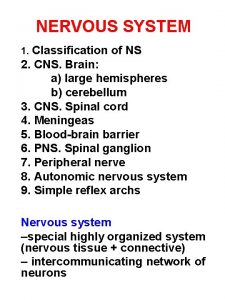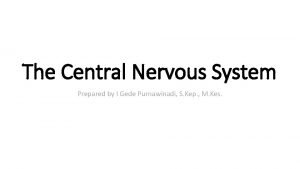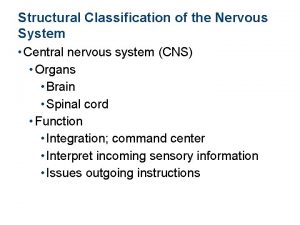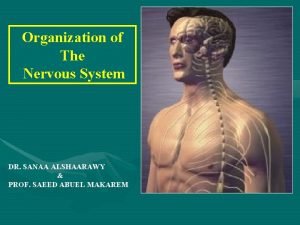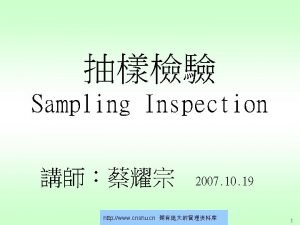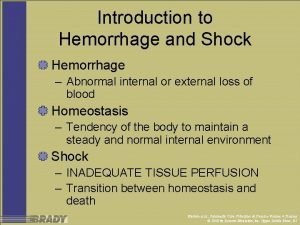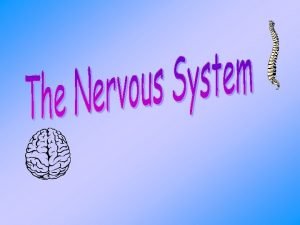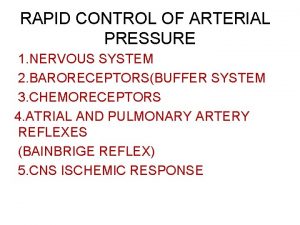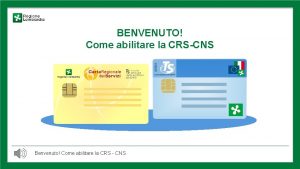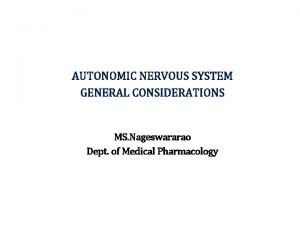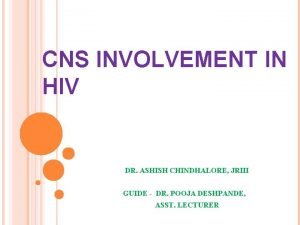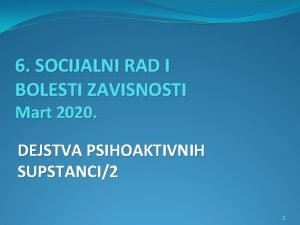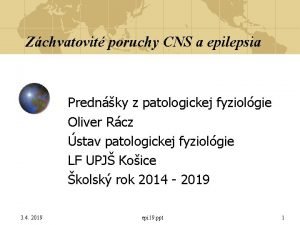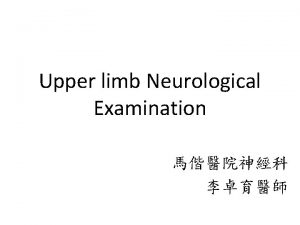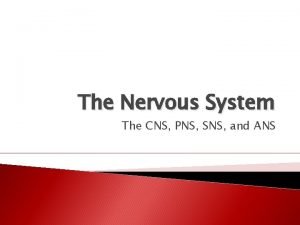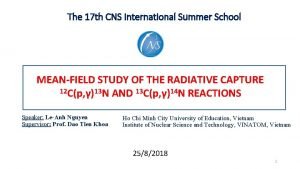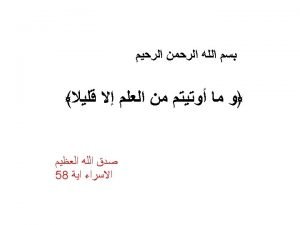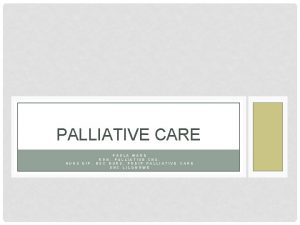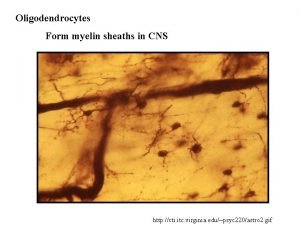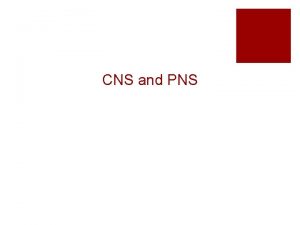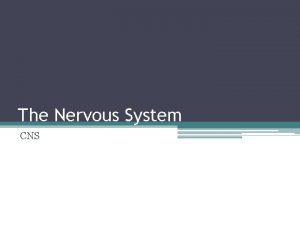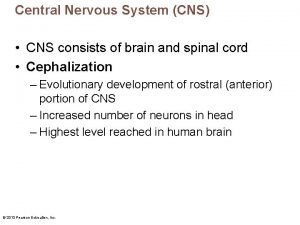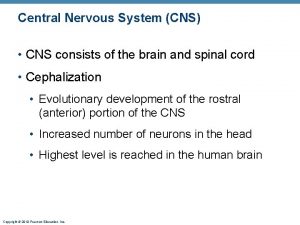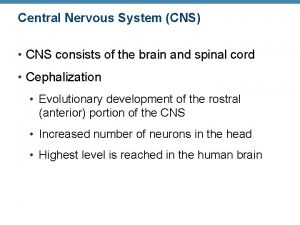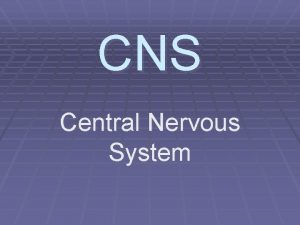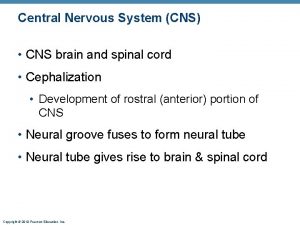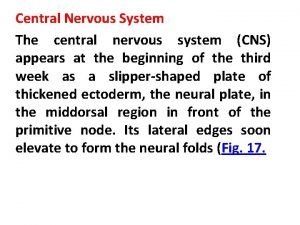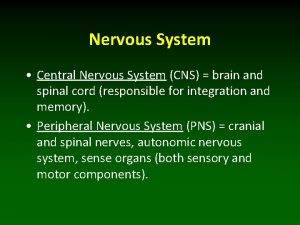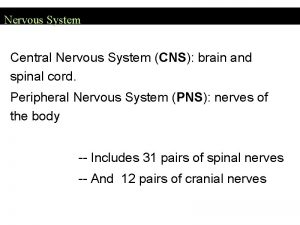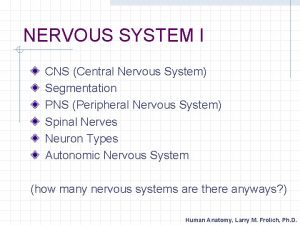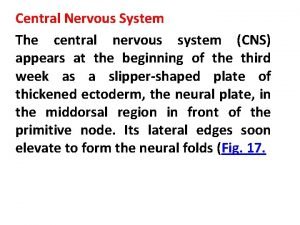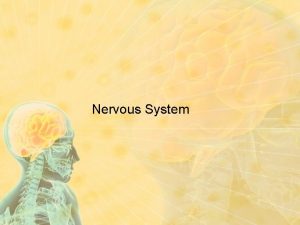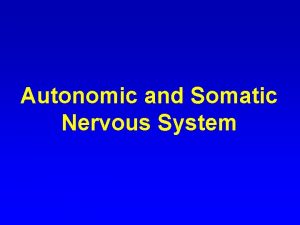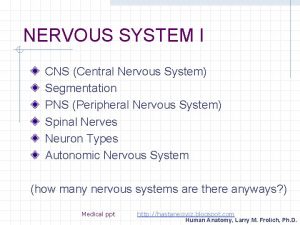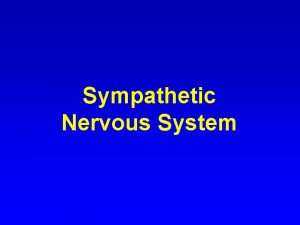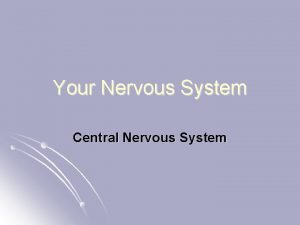NERVOUS SYSTEM 1 Classification of NS 2 CNS
































- Slides: 32

NERVOUS SYSTEM 1. Classification of NS 2. CNS. Brain: a) large hemispheres b) cerebellum 3. CNS. Spinal cord 4. Meningeas 5. Blood-brain barrier 6. PNS. Spinal ganglion 7. Peripheral nerve 8. Autonomic nervous system 9. Simple reflex archs Nervous system –special highly organized system (nervous tissue + connective) – intercommunicating network of neurons


CLASSIFICATION Anatomical (structural): central nervous system (CNS) – brain and spinal cord peripheral (PNS) – endings, fibers, ganglia, plexuses Functional: - somatic (voluntary, animal) - autonomic (involuntary, vegetative)

FUNCTIONS 1. Integration 5. Conduction 2. Control 6. Analysis 3. Regulation 7. Response 4. Reception NERVOUS SYSTEM ORIGIN Ectoderm - neural tube and ganglious lamella and placodes Cranial portion of neural tube – brain and sense organs Middle part of neural tube and ganglious lamella– spinal cord, dorsal-root ganglia (spinal ganglia), autonomic ganglia and chromaffin tissue of human body. NEURAL TUBE ZONES Ependymal – precursors of glial ependymal cells Mantial layer – neuroblasts (nerve cells) and spongyoblasts (astrocytes and oligodendrocytes) Marginal zone – processes

BRAIN Histologically: gray matter (nerve cells bodies) white matter ( nerve fibers) Gray matter: cortex + subcortical nuclei MODUL – MFU of brain cortex cilinder d 300 mkm around corticocortical fiber NEUROPIL – aggregations of nerve and glial cells processes in central nerve system CYTOARCHITECTONICS - well prominent regular location of nervous cells (6 layers in hemispheres) MYELOARCHITECTONICS - well prominent regular location of nervous fibers (4 layers)

Cytoarchitectonics Brain cortex has 6 layers Pyramidal cells in the 2 nd, 3 rd, 4 th, 5 th layers

Layers of brain cortex 1. Molecular layer 2. Outer granular (10 mkm) 3. Pyramidal (10 -40 mkm) 4. Inner granular layer 5. Ganglionic (120 x 80, Bets, 1874) 6. Multiform layer


MYELOARCHITECTONICS 1. Above the 1 st layer 2. Under the 1 st layer 3. Above the 5 th layer 4. Under the 5 th layer TYPES OF NERVE FIBERS Associative Comissural Projective

52 FIELDS OF BRODMAN GRANULAR CORTEX – sensory (2, 4) AGRANULAR CORTEX – motor (3, 5, 6)

CEREBELLUM


Functions: 1. Coordination 2. Movement 3. Balance 4. Muscle tone

Molecular layer: basket cells large stellate cells small stellate cells Purkinje cells layer: Purkinje cells, supporting cells (lophogliocytes) Granular layer: corn cells stellate cells (2 types) horizontal cells

CEREBELLUM Afferent fibers: Mosslike– from olives and pons to the corn cells - tr. Olivocerebellaris - tr. pontocerebellaris Climbing–from spinal cord and vestibular nuclei to the Purkinje cells - tr. spinocerebellaris - tr. vestibulocerebellaris Efferent fibers: axons of Purkinje cells

Spinal cord



Spinal cord Types of neurons: 1. Radicular 2. Funicular 3. Inner Nuclei Posterior horn: n. proprius n. thoracicus Intermediate horn: n. intermediolateralis n. intermediomedialis Anterior horn: 5 motor nuclei

MENINGEAS

MENINGEAS Skull bone Periosteum of skull epidural space 1. DURA MATER – dense connective tissue epithelium subdural space 2. ARACHNOID – flat epithelium fibrocollagenous tissue web-like strands subarachnoid space 3. PIA MATER – squamous epithelium – loose connective tissue with blood vessels and nerve fibers Basement membrane Glia limitans (astrocytes) Nerve tissue

BLOOD-BRAIN BARRIER Prevents diffusion of some substances from the blood to the brain Capillary wall 1. Endothelium 2. Basement membrane 3. Glial sheath (foot processes of astrocytes)

DORSAL ROOT GANGLION capsule pseudounipolar cells mantial cells


PERIPHERAL NERVE

PERIPHERAL NERVE ULTRASTRUCTURE

AUTONOMIC NERVOUS SYSTEM Anatomically: a) central b) peripheral Functionally: a) sympathetic b) parasympathetic SYMPATHETIC NS 1. Centers: thoracic-lumbar disposition Nuclei intemediolateralis of spinal cord – multipolar associative radicular neurons 2. Sympathetic ganglia: paravertebral (trunci simpatici) and prevertebral (3) PARASYMPATHETIC NS 1. Centers: cranio-sacral disposition Nuclei of cranial nerves III, VII, IX and X pairs 2. Extramural and intramural ganglia (Dogel cells)

AUTONOMIC NERVOUS SYSTEM

AUTONOMIC GANGLION Golgi cells type I type III


NEURONAL THEORY • Reflex arch is morphofunctional unite of nervous system • This is group of nerve cells which may transmit nervous impulses • Transmitting of nervous impulses is unidirectional

 Fundamentals of the nervous system and nervous tissue
Fundamentals of the nervous system and nervous tissue Fundamentals of the nervous system and nervous tissue
Fundamentals of the nervous system and nervous tissue Nerve cell process
Nerve cell process Cns classification
Cns classification Reeling gait
Reeling gait Classification of nervous system
Classification of nervous system Structural classification of the nervous system
Structural classification of the nervous system Classification of nervous system
Classification of nervous system Nervous system and digestive system
Nervous system and digestive system Endocrine system and nervous system
Endocrine system and nervous system Endocrine vs nervous system venn diagram
Endocrine vs nervous system venn diagram Endocrine system
Endocrine system Iso 2859抽樣計畫表
Iso 2859抽樣計畫表 Naas cns
Naas cns Cns ischemic response
Cns ischemic response Nervous tissue histology ppt
Nervous tissue histology ppt Composition of cns
Composition of cns Cns ischemic response
Cns ischemic response Mean arterial pressure
Mean arterial pressure Cns ischemic response
Cns ischemic response Www.lispa.it cns
Www.lispa.it cns Ans and cns difference
Ans and cns difference Cns depressants ppt
Cns depressants ppt Cns
Cns Depresori cns
Depresori cns Cns international school
Cns international school Cns poruchy
Cns poruchy Neuro motor exam scale
Neuro motor exam scale Dermatome map
Dermatome map Cns summer school
Cns summer school Sensory system diagram
Sensory system diagram Cns ward
Cns ward Cns
Cns



